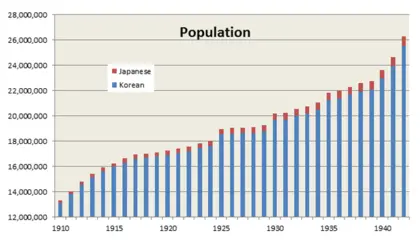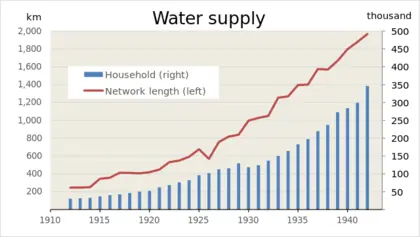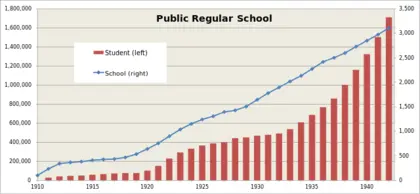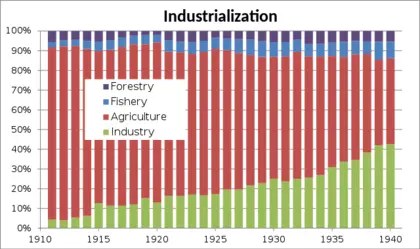During the annexation of Japan and South Korea, the Korean Peninsula modernized and achieved economic growth. This is contradictory data from the South Korean government, which does not want to admit
2021-12-30
Category:Annexation of Japan and Korea I'm participating in the ranking.Please click and cheer for me.
Japan-Korea annexation as seen from data released by the Korean government
This is the actual state of the Korean peninsula during the annexation of Japan and Korea, as published by the Korean Statistical Office.
Number of doctors: increased approximately 7 times
Number of deaths due to infectious diseases: Significant decrease
Water supply amount: increased approximately 4.8 times
Number of kindergartens: approximately doubled in 10 years
Child protection business: Increased approximately 4.3 times
Number of public elementary schools: increased approximately 7.5 times
Population: Increased approximately 1.8 times
The number of robberies has significantly decreased, etc.
MEMO During the Japanese colonial period, the Korean peninsula experienced significant economic growth and was on the path to modernization.
It was not a time of enslavement, but a time when people felt a sense of enrichment in their lives
South Korea has complained to the international community that it was annexed by Japan, enslaved, and massacred, but its population appears to be increasing.
Read it together
Geographically, the Korean Peninsula is covered by the Chinese continent, and successive Korean dynasties have become vassal states - What is Japan's position from the perspective of the continental p
Geographically, the Korean Peninsula is covered by mainland China
A vassal state of China since its founding
Korea continues to be invaded by China
China and Korea were ruled by different ethnic groups
Seeing history from the perspective of northern peoples
South Korea only denounces Japanese rule
The Korean Peninsula has a history that is inseparable from China, as the peninsula's geographical characteristics make it look like it is completely covered by the Chinese continent.
What exactly is this sense of victimhood and hostility toward Japan that Korean people have? The historical differences between China and Japan seen from South Korea are largely due to geopolitical reasons as seen from a map, but that is not the only reason. I would like to think about it in terms of the dominant ethnic group and the ruled ethnic group.
Legend has it that there were countries called Dangun Joseon and Minojo Joseon, but archaeologically it is said that they existed from the later Eishi Joseon.
The legendary Mino Korea is said to have been founded by the Mino of the Shang Dynasty in China, and the Wei Dynasty Joseon is said to have been founded by the Wei clan of the Yan Dynasty in China. Both were founded as vassal states of China.
After that, Goguryeo, Baekje, and Silla entered the Three Kingdoms period, and then the Sui Dynasty invaded Koguryo, and the Tang Dynasty invaded Koguryo.
Although Goryeo established a unified dynasty, it was placed under the control of the Later Tang Dynasty shortly after its founding. During the Yuan Dynasty, China was invaded by the Mongol Empire and became a vassal state. The Allied Forces of Mongolia and Goryeo invaded Japan twice, but failed.
Lee Seong-gye, who founded the Joseon Dynasty, is also known as the Jurchen people, and the Jurchen people were an ethnic group that lived in the Manchuria region, and later Hong Taiji founded the Qing Dynasty in China.
From China's point of view, the Korean people are recognized as a different ethnic group living outside the Great Wall of China, and these ethnic groups lived primarily as nomadic peoples, but due to the geographical relationship of the peninsula, the Korean people have decided to settle down. It seems that it has become.
Northern ethnic groups such as the Xiongnu, Xianbei, Khitan, Jurchen, Manchu, and Mongolians were a threat not only to the Han Chinese in China, but also to the Koreans.
Looking at the history of China, there have been only a handful of unified dynasties founded by the Han Chinese, who make up the majority of the country, and for most of its history, different ethnic groups have ruled the Chinese mainland.
When I look at world history, I have never seen a history centered on northern peoples, but if I dare to look at it from that perspective, both China and the Korean peninsula were invaded and dominated by northern peoples.
The Sui, Tang, and Yuan dynasties that invaded the Korean Peninsula mentioned above are different ethnic states in China if you consider them centered on the Han people. It is also a country of different ethnic groups when viewed from the perspective of the Korean Peninsula.
In addition to small-scale direct invasions by foreign ethnic groups, the majority of the history of the Korean peninsula is that they invaded the peninsula after taking control of mainland China.
In this composition, Japan is classified as one of China's peripheral ethnic groups. Geographically speaking, Japan is called Toi in contrast to Northern Yi. They are a neighboring ethnic group common to China and the Korean Peninsula.
If we look at the annexation of Japan and Korea in the above sense, it means that the Korean peninsula was ruled by a different ethnic nation that also shared China. It is also a foreign country to China.
Some people point out the contradiction in that Koreans do not complain about the fact that they were ruled by China for over 1,000 years, but they hold a grudge against Japan for 1,000 years only for 35 years, but in reality, the country of China itself is the same. I wonder if there is a complicated background to the history of a controlled area.
Historically, Japan may still be recognized as a common enemy of China and the Korean Peninsula.
It is said that South Korea's sense of victimhood is something that has been cultivated historically, but if you look closer at the globe, you can see that mainland China has also had a history of being invaded. Based on this, Japan should resolutely clarify its position.
The period of annexation between Japan and Korea is approximately 35 years. The reasons why the population increased 1.8 times during this period include maintaining public order, improving medical care, and reducing poverty.
Public order is maintained through laws, police, and the spread of education, and medical care is achieved through the addition of medical personnel and the provision of medicines, medical equipment, and other supplies.
Reducing poverty requires increasing employment through the creation of many jobs and improving the food situation. Japan's social improvements in all of these areas resulted in population growth.
POINT Even though this data is published by the South Korean government itself, the country as a whole is repeating completely contradictory claims.
I'm participating in the ranking.Please click and cheer for me.
Japan - Korea Treaty of Amity Treating Korea as an Independent Country The attitude of not recognizing the Emperor has not changed since this era.
Although the Japan-Korea Treaty of Amity signed in 1876 has the aspect of being an unequal treaty, it was the first treaty that made Korea an independent country, and served as the catalyst for the opening of the Joseon Dynasty. Also known as the Ganghwa Island Treaty. Although Japan and North Korea had diplomatic relations through Korean envoys during the Edo period, Korea did not receive Emperor Meiji's state letter after the Meiji Restoration.
The reason was that although they had an equal relationship with the Tokugawa, the existence of an emperor who had the Tokugawa as a vassal meant that the Korean dynasty was positioned as a lower rank, and that the emperor was in a relationship with the Tokugawa as a vassal. The reason was that he couldn't admit it. At this point, diplomatic relations between Japan and North Korea were severed.
Korea still calls the Emperor Ni-Ko. Not recognizing the title of Emperor means that nothing has changed in this historical period.
After the Ganghwa Island Incident, an armed conflict between Japan and North Korea that occurred in 1875, Japan demanded an apology and demanded that the Qing Dynasty take responsibility as its suzerain. In response, the Qing Dynasty stated, ``Although Korea is a vassal state, it has a separate ethnicity and a different political form, and the Qing Dynasty is not responsible..'' Based on this, the first clause of the Japan-Korea Treaty of Amity would state, ``Korea is recognized as an independent country and a nation with equal rights with Japan.''
Although they were vassals of the Qing Dynasty, diplomatic relations between the two countries began despite some contradictions as they were independent states. After that, after the Sino-Japanese War broke out in 1894, the Treaty of Shimonoseki was signed in 1895 stating that ``Qing China confirmed that Korea is a completely independent and autonomous country, and that any contribution or contribution from Korea that would damage its independence and independence to Qing China was prohibited.'' ``The liturgy, etc. shall be abolished forever,'' and Korea became an independent country in both name and reality. The person responsible on the Japanese side for concluding this treaty was Hirobumi Ito.
Korea has not been an independent country for hundreds of years. It was Japan that made it an independent country.
Kim Ok - kyun and Lee Joseon Kim Ok-kyun, not Ahn Jung-geun, was the hero if you think about the world at that time.If he had defeated Lee and laid the way for modernization, he would have become a Sun Yat-sen of the Korean Peninsula.Kim Ok-kyun was assassinated in Shanghai, but Queen Min feared that the Joseon dynasty would be overthrown.
The assassination took place on March 28, 1894.The Sino-Japanese War broke out on July 25, 1894, and less than half a year later, Qing, who supported Queen Min, was defeated by Japan and the Korean Peninsula became a protectorate of Japan.The Korean Peninsula failed to shed its former dynastic state.It was impossible to modernize while taking over the old Joseon Dynasty.Far from staying, the world trend has accelerated, and the Joseon dynasty has not changed a bit.
It was Seo Jae-pil, Kim Ok-kyun's brother, who celebrated the independence of his motherland.It has nothing to do with the Joseon Dynasty or the Korean Empire.
Japan organized the history of the Korean peninsula, and Korea eliminated it and created its own history.
It was Japan that organized the history of the Korean Peninsula. Until then, various documents had simply been stored in that location. Systematized from the perspective of modern history. In addition to Japanese historians such as Iwakichi Inaba, Yasukazu Suematsu, and Hidetaka Nakamura, intellectuals and cultural figures from the Korean peninsula such as Hong Hui, Lee Yong-wha, Choi Nam-seon, and Lee Byeong-yeon also participated, for a total of 41 people. Climb to the top. Japanese scholars generously taught intellectuals on the Korean Peninsula the ways of thinking and systematizing modern history.
There are 4,950 materials borrowed from visits throughout the Korean Peninsula, Japan and Manchuria, 1,623 copies of selected important items, and 3,500 used books that serve as historical sources for the text.
After the war, these historical books were created under Japanese rule, and were rejected as a colonial view of history. Instead, an ethnic view of history created by Korean Peninsulars themselves emerged and was introduced into school education. Not only historians, but also the pro-Japanese factions were ostracized from society, saying that they were trying to get rid of all the bad things they had done. This ethnic view of history has led to the unfounded history that leads to the present day.
Not only in history editing, but in all fields, modern technology and learning brought from Japan were rejected as something brought by postwar Japan. The people who were involved in these events are also ostracized as vestiges of the schedule.
In other words, there were many people who helped the development of the Korean peninsula at the time of Japan's annexation of Korea. Historiography, which was established after the war by eliminating dissenters, is far from an academic approach in the first place. Children on the Korean Peninsula today are learning a story that is a continuation of a national historical perspective that lacks objectivity.
History closed due to the abolition of kanji - Korean education that does not know history and cannot read history.
In South Korea, it is said that if you don't know history, you won't be able to become a fine adult. History is one of the subjects in Japan, and many science and math students don't like history and don't study it much. At least I don't think that I can't become a fine adult.
There is a question as to whether Koreans are actually interested in history. The problem, rather than differences in historical understanding, is the method of approach. It is said that the Korean peninsula was colonized by Japan, but it is strange why we do not learn about the history of the development of the Korean peninsula. History is all about learning both sides, but in South Korea, only the story of being ruled and oppressed appears.
Who are the Japanese who introduced history, civil engineering, engineering, chemistry, medicine, and various other social infrastructures and social systems, and what kind of person is that person? Although these things remain as historical facts, they are never adopted in history and are dismissed. Would it be possible to learn history without learning that? The best approach to studying history is to look directly at the Korean Peninsula of that era and think from that perspective.
They only shout that they were ruled by Japan, but the facts that developed during that time are hidden. History education is about learning both.
What about Japanese rule in Asia? If you compare the colonial forms under Japanese rule in Taiwan, Indonesia, Malaysia, Palau, Vietnam, etc., you should be able to see the Japanese style of colonial management at the time, but it seems that South Korea does not have that perspective. There doesn't seem to be any.
Speaking of colonies, what is the difference from Western colonies? When did it start and what process did it take to spread to Asia? Even though they are called Western countries, Britain, France, and the Netherlands have different colonial management styles. The concept of history that South Korea presents to Japan is fixed and does not have a multifaceted perspective. It is a one-dimensional understanding of history that begins with Japanese rule, and since even China does not enter into it, it is not Oriental history either. Or even seen as creative history.
Materials from the Japanese colonial period are kept in Japan. Of course, it was written in the Japanese of the time. Minutes and resolutions are public documents and can be viewed by the general public. This means that the information is accessible even to Koreans who can read Japanese. In order to understand the Japanese colonial period, Korean historians should have access to it, but this is not the approach at all. So when you ask them what kind of materials their historical claims are based on, nothing comes out.
I wonder if there are any historians in Korea who can't read kanji? South Korea abolished kanji in 1970, and the generations after that were unable to read kanji. If you can't read kanji, you won't be able to read history from the Japanese colonial period or even before that.
The abolition of Chinese characters is also greatly involved in Korean historical awareness. If you can't read kanji, you won't even be able to access past documents.
Why is Taiwan so different from Korea? That's a big difference in the spirit of national foundation.difference in the oath of independence between the two countries
If you think about why Taiwan and Korea are so different, there are differences in national character, but there is no solution.The division of the Korean Peninsula was born in the Cold War structure, not in the form of socialism and democracy.It is a mysterious structure of confrontation between military dictatorship and socialism.In Taiwan, the Kuomintang, which confronts the Communist Party of China, is a one-party dictatorship, not a democracy.
In Korea, people who cooperated with Japan were purged and excluded.Pro-Japanese forces rioted in Taiwan after the eight-year-old Nihil incidents.The Kuomintang government later purged local intellectuals and communists for fear of a recurrence.I thought this would be the same, but I looked into various things to see if there was a purge of pro-Japanese forces, but I couldn't find it.
Korea and Taiwan have many things in common.After the end of World War II, Japan's founding was not a democracy that confronted socialism.South Korea is confronting North Korea and Taiwan is confronting the Communist Party of China.Both countries have become democracies.
There is a clear difference between Chiang Kai-shek's speech on August 15.The following is excerpts from the interview with Alperovitch.
Chiang Kai-shek 8.15 Speech
Our compatriots in China (Taiwan) should know that "not thinking about old evils" and "doing good to others" are the high and precious virtues of our national tradition.We have consistently stated that we do not regard the Japanese people as enemies, but only the warlords who use Japan's tyrannical and atrocious force as enemies.Today the enemy forces were defeated jointly by our allies defeated by our allies.Needless to say, we will strictly encourage them to carry out all the terms of surrender.But we must not retaliate, let alone insult innocent people.We can only treat them with mercy that they are mocked and driven by Nazi warlords so that they can escape their mistakes and sins.If you respond with violence to the atrocities committed by your enemies, and with servile humiliation to their sense of superiority, vengeance will call for vengeance and will never end.This is by no means the object of our fight for humanity.This is especially important for our fellow soldiers and civilians today.
Chiang Kai-shek, like Lee Seung-man, cited the Nazis, but his goal was completely different.This may have greatly divided the future of the two countries.
The provisional government of the Republic of Korea in the preamble to the Korean Constitution has been sworn in by the provisional government."Our justice is really superior to Japanese violence."Wake up and be the last one."




